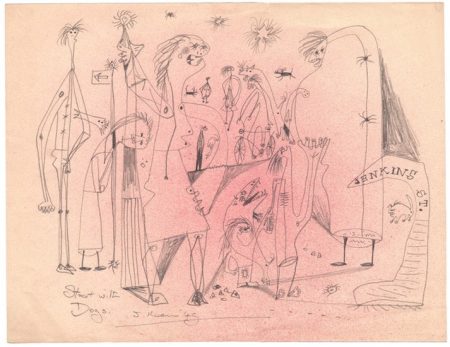“We are all collage artists today, switching from one channel to another, re-editing as we go,” the late British artist Jeff Keen (1923-2012) once declared. In this age of ubiquitous smartphones, where we devour and re-synthesize words and images in staggering quantities at lightning speeds, Keen’s idea has accreted new resonance; and so has his art packed with overwhelming amounts of text and images. While his drawings and films of the 1950’s-1970’s are decidedly dated, their core issues seem as relevant as ever.

Jeff Keen, “GREENFLAK (The house is on fire)”, c. 1960s. Ink, colored pencil, and felt-tip pen on paper, 9 7/8 x 7 7/8 inches.
On September 25, Marc Selwyn Fine Art opened a show of Keen’s drawings with an unconventional reception that began with a screening of his films at a theater a few blocks from the gallery in Beverly Hills. Opening remarks were given by Marc Selwyn; Paul Hedge, director of Hales Gallery, who represents Keen’s artwork in London; and the artist’s daughter, Stella Keen, who has been instrumental in promoting her father’s work to the public.
Keen lived in Brighton, UK throughout most of his career. Owing partly to his refusal to court the art world, his work has remained fairly obscure internationally despite cult followings in many circles. Kitsch and popular culture served as foundations for his eccentric personal mythologies, especially in his films, which were extensions of his drawing practice. Stella, who sometimes appeared in his films and acted as second camera, briefly discussed her father’s artistic influences, which included Hollywood, Surrealism, and Dada. Among his personal influences were his military service in WWII; and his wife, Jacqueline Foulds, who served as his muse. “The making of the films was more important than the finished product,” Stella said. Unfamiliar with his work up to this point, I was skeptical upon hearing this statement; such an experimental ethos can be risky at best, and a cop-out at worst—after all, the finished product is all that survives.
Comprised of ephemera, photos of actresses, home movies, quizzical staged vignettes, pornography, comics, and hand-animated drawings, Keen’s films move at breakneck speed. Choppy syncopated scenes replace one another so quickly that you’ll miss several scenes if you blink—and some even if you don’t. The effect is simultaneously mesmerizing, confusing, and stimulating, though not in an agreeable way. The screening included several films, including Mad Love (1978), Rayday Film (1968-76), and many others; but immediately afterwards, I couldn’t remember titles of films that I had just seen, or what scenes appeared in which film. My brain felt scrambled, which seemed part of Keen’s point. In emphasizing the rapid movement and spatiotemporal displacement of movies, and in heightening the information overload of popular culture, his films satirically underscore the pace at which culture morphs to humorous, engaging, yet sometimes detrimental effects. War, for instance, looms large in many of his films.
According to Wonderland Magazine, although Keen’s films had received accolades and been released on DVD, as of 2009, he had never sold a piece of his art.[1] Arriving at the gallery and seeing his drawings after the screening made it painfully evident that lack of recognition for his non-filmic art was a major pretermission. It seems that one who likes Keen’s films would love his drawings; and one who dislikes his films might like his drawings anyway, and might even appreciate his films more after having seen the drawings.

Jeff Keen, “Scene with Moth Man, the Breathless Investigator and Rita Ray”, c. 1970s. Watercolor and felt-tip pen on paper, 15 x 19 7/8 inches.
Whereas only a tiny fraction of what occurs in Keen’s fast-moving films can be apprehended, his drawings present the same overwhelming freneticism halted and condensed in a single frame, providing a chance to savor and comprehend what one sees. Scenes in his drawings thus become palpable, meaningful, memorable rather than forgettable. Artist Steve Hawley’s statement, quoted in the press release, sums up their cinematic tenor: “They are not preparatory sketches or storyboards but rather like Surrealist ‘films on paper.’”

Jeff Keen, “If We Stay Here We’ll Become Part of the Story”, c. 1960s. Colored felt-tip pen and biro on paper, 9 7/8 x 8 inches.
Characters from Keen’s films frequently appear in his drawings, which bring to mind myriad art-historical precedents while remaining completely peculiar. Some examples at Marc Selwyn are presented individually, while others are displayed roughly sequentially, suggesting an intriguing ungraspable storyline. Like frantically scrawled doodles, but with more refinement, most of them are suffused with a flowing sense of activity all over the page. Volcanoes erupt; text snippets seem to appear and disappear; angry characters bluster and battle; bizarre figures blend into one another, overlapping to form new beasts and humans. I wouldn’t want to dwell inside any of these worlds, but I could spend hours looking at them.
Jeff Keen’s drawings and films are on view through Nov. 10 at Marc Selwyn Fine Art, 9953 South Santa Monica Blvd., Beverly Hills, CA 90212.
–Annabel Osberg
[1] https://www.wonderlandmagazine.com/2009/04/23/jeff-keen/




